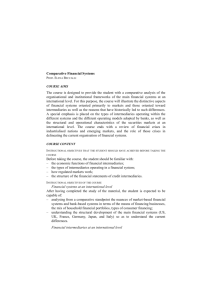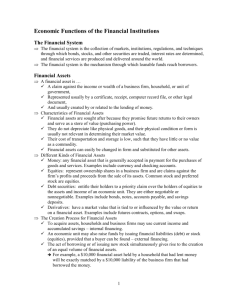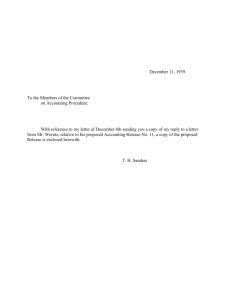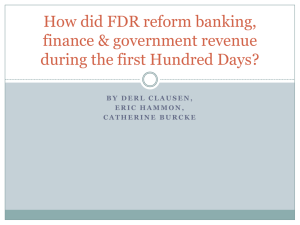PPP
advertisement
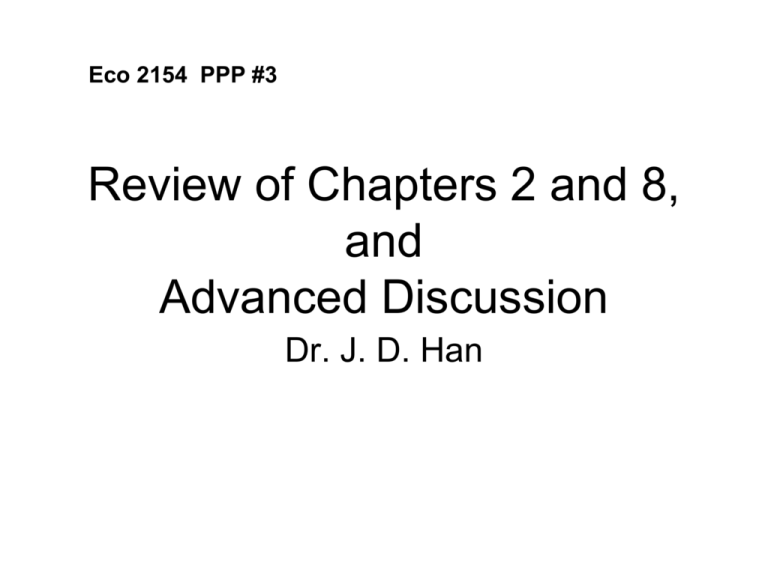
Eco 2154 PPP #3 Review of Chapters 2 and 8, and Advanced Discussion Dr. J. D. Han When a Company needs funds for a project, how would it do? - It is in the Primary Market, not in Secondary Market, that a non-financial corporation raises the fund • Internal financing: use accumulated funds from Undistributed Corporate Profits • External financing: get the funding from outside of the company Out of two External Financing Methods, Indirect Financing predominates. Direct Finance vs. Indirect Finance Indirect Finance Through Financial Intermediaries Savers Households Investors Financial Market Direct Finance Doing by itself Business Firms Who does Indirect Financing? Financial Intermediaries, which consists of Depository Institutions (banks, trust co., credit unions), Investment Intermediaries (securities co., finance co.), And Contractual Savings Institutions (insurance co, pension funds). What are being Dealt in? Financial Instruments Indirect Marketable Securities indirect Debt Contract or Instruments Bank Loans Bonds Stocks(equities) In theory, they can be instruments for Direct Financing as well. However it is pretty small. (Review ) Observation of Facts: Sources of External Corporate Financing in U. S. : 1970-1985 stocks 2% bonds 32% loans 66% Note: these are funds raised through issues of ‘New Securities-Stocks and Bonds’. Of course, stock exchanges trade ‘existing’ stocks as well, which account for the majority of the outstanding market values. Puzzle 1: Stocks or Equities are relatively unimportant compared with Debt Contracts/Instruments (= Bonds + Loans) Puzzle 2: Marketable Securities(=Bonds + Stocks) are not so important as Bank Loans Puzzle 3 • Direct Finance is insignificant compared to Indirect Finance. • Financial Intermediaries buy most of Marketable Securities Answers to All these Puzzles 1) FI Lowers Transactions Costs due to expertise and EOS 2) Information Asymmetry 3) Capital Structure - interest payment is tax-deductible - real cost of borrowing is the (actual) real interest rate (=nominal interest rate – inflation rate) 4) Issues of Management Control and a 1) Provides rationales for Financial Institutions; 2) Provides grounds for Government Regulations of Financial Institutions/Financial Sector. Let’s focus on the second issue of Government Regulations In Chapter 2, we have learned that government regulation is necessary because of the intrinsic problem of the Financial Sector, that is, Information Asymmetry. In case of indirect financing, Information Asymmetry occurs at 2 levels: between lenders and FI, and FI and borrowers. *Etymology: “A-sym-metry” means Not-the samenessof proportions, from Greek word from asymmetros, from a- "not" + symmetros "commensurable." Information Asymmetry leads to: • Ex-ante (Before Deal) May lead to Adverse Selection Problem “Lemon and Jewel problem” -Definition: Bad financial intermediaries/assets look better than good financial intermediaries/assets. • Ex-post (After Deal) May lead to Moral Hazard Problem -Definition: Once being given money, the so-far-good borrower is subject to the hazard to be engaged in riskier activities than are agreed with the lender. Adverse Selection: “Fatal Attraction” • Called “Lemon & Jewel Problem” by G. Ackerloff • Security price is set between value of a good firm and value of a bad firm: Securities Market (overvalue/undervalue) bad borrowers’ securities and (overvalue/undervalue) good borrowers’ securities. Now, how can we reduce/resolve Information Asymmetry? Information Production =Monitoring To what degrees are Financial Institutions successful in generating Information? -”Not Complete”, and “Varying Degrees”: Thus it is argued that Government Regulation should fill in for Information Generation/Revelation, and different Financial Institutions are to be faced with different degrees of market receptions and government regulations IA: Marketable Securities versus Bank Loans • bank loans are less subject to information asymmetry than Marketable Securities. Thus, the financial investor prefers bank loans to marketable securities. Why? The key lies in that enough information is generated about the borrower in the case of bank loans which can use Restrictive Covenant. • Still banks cannot completely remove Moral Hazards of borrowers. • Japanese banks may have the answer for a further reduction of IA and Moral Hazards. IA: Equities versus Debts • Equities without Restrictive Covenant are subject to a more severe Moral Hazard Problem than debts with Restrictive Covenant are. • This particular problem in equity contract is called the “Principal-Agent Problem” • Thus, equities have doubly risky in the eyes of finanical investors, and get less fund(demand). * Wait a second, this has not been the case all the time in financial history: J. Bradford De Long at Harvard Univeristy concludes: “……Up to the 1920s (prior to GlassSteagall Act), Financial Trusts were less subject to Moral Hazards of their borrowers……” (Recap) Why should the financial industry be regulated by government? • Because Information Asymmetry is an intrinsic problem of the industry: adverse selection and moral hazards • Information Asymmetry is not to be completely resolved in the market. • Ultimately, Public Provision of Information is required,which calls for Government Regulation. However ……. The above view is a majority view, but everyone does not agree with it. This revisionist view has been gaining an increasing popularity in the era of financial liberalization. First, Information Asymmetry is a fact of life, and does not have to automatically ask for government intervention. Marriage is subject to IA. However, there is no room for public intervention in private marriage. The reason is that “enough, if not complete, information is produced/demanded by individuals. Second, Government Intervention should be preceded by Private Information Market Failure And this happens in the Securities Market as opposed to Bank Loans due to Information Free Rider Problem Only then, public intervention is justified, but even it is not the only solution and is not for ever. To Recap, Private Information Market fails (to coordinate Demand and Supply of information) if there is Free Rider Problem. This is the case of Securities Market, where multiple lenders(financial investors) buy a lender(borrower)’s securities. “Who is willing to pay for information?” *Can you again explain how the Private Information Market fails in the securities market? • Information is about ______________ • Demand of Information by __________ • Supply of Information by _________ • Why wouldn’t be enough of supply of information? • Information Revolution will resolve Free Rider Problem eg) Microsoft Operating System has become non-duplicable or nontransferable. • Meanwhile, within industry, Merger & Acquisitions will reduce Moral Hazards Historical Evidence also tells us: Would enough, if not complete, information be generated in the unregulated financial sector so as to ensure that the investor with due diligence or prudence may be protected from frauds in a reasonable way to a certain acceptable degree? If so, government intervention is not necessary. Theoretically, it is possible, and empirically, there is a historical evidence from the Free Banking System experiences. Free Banking: Free Entry and Self Regulated Note Issues Historical Instances of Self-Regulated, or Free-Market Financial Industry • • • • • Scotland: 1720-1840 U. S. A.: 1836/7-1863 Canada: prior to Bank of Canada 1935 Sweden: 19C Hong Kong: Contemporary Were They Stable? • Conventional Wisdom -> Yes, Scotland, Canada, Sweden and HK -> “No”, U. S. A. We would like to challenge the second part of Conventional Wisdom Scottish Free Banking: • Period: 1720-1840 • How did it work?: -Banks could print out paper monies, or notes as long as they do not default on redemption request of the notes for species -No government charter needed; Self regulated, competitive (free market driven) supply of money and banking practices * Evaluation of the Scottish Free Banking Compared with the Contemporary British Banking Experience 1. Stability: no major bankruptcy -exception: Ayr Bank 2. Availability: more banking services per capita 3. Competition: small banks along with large ones 4. Efficiency: - spontaneous evolution of a clearing house (payment association) - Rapid propagation of information American Experiences Free Banks were viciously called “Wildcat Banks”. However, Revisionist Studies by A. Rolnick and W. Weber have proved that they were Not So Bad. Why? *Three Point Arguments The bank note holders(lenders) had been well informed of the true value of the assets/notes from Minnesotan Free Banks.” : Free Market is more efficient in propagating information than we might expect (Evidence: Well conversed the New York/Chicago Market Value of Lessons to be Learned from Free Banking Experiences Self-Regulated, Regulation-Free, Banking/Financial Industry may be Viable and even be superior. Securities Market • From studies on the Amsterdam Bourse of the 17th century, Edward Stringham of UC San Jose, concludes: “…In the 1600s, the first century when equities were traded, we can see that there was a considerable degree of financial innovation. We also see that most of the financial instruments were officially outlawed by the state. Brokers discovered new trading instruments and abided by their contracts not because of legal compulsion but because of market incentives. The regulations were not advancing the market, they were trammeling it, though the market developed in spite of the law. Contrary to the idea that the government is needed for financial innovation and contractual performance, the case of the Amsterdam Bourse provides evidence that securities markets can function successfully with little assistance from the state…..” References • Read Neil Reynolds’s inspiring article on the Dutch Securities market of the 16th Century, entitled, “Self-regulation: The Dutch had it right,” The Globe and Mail, Aug.12, 2006. • Edward Stringham, “The extralegal development of securities trading in seventeenth-century Amsterdam”, The Quarterly Review of Economics and Finance, 43 (2003) 321–344 • J. Bradford De Long, Harvard University, “Did J. P. MORGAN’S MEN Add Value?: An Economist’s Perspective on Financial Capitalism, 1995. • Kam Hon Chu “ Is Free Banking More Prone to Bank Failures than Regulated Banking?”, Cato Journal, Vol. 16 No. 1 • Sun Bae Kim, “Banking and Commerce: The Japanese Case”, Federal Reserve Bank of San Francisco Weekly Newsletter, March 1991. • A.J.R. Rolnick and W. Weber, "New Evidence on the Free Banking Era," American Economic Review, 1983, Vol. 73, No. 5:1080-1091 • A.J.R. Rolnick and W. Weber, "Explaining the Demand for Free Bank Notes," Journal of Monetary Economics, 1988, Vol. 21: 47-71.

